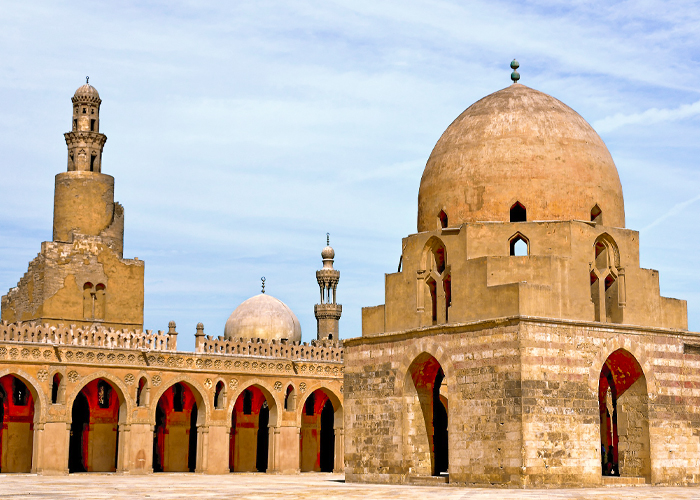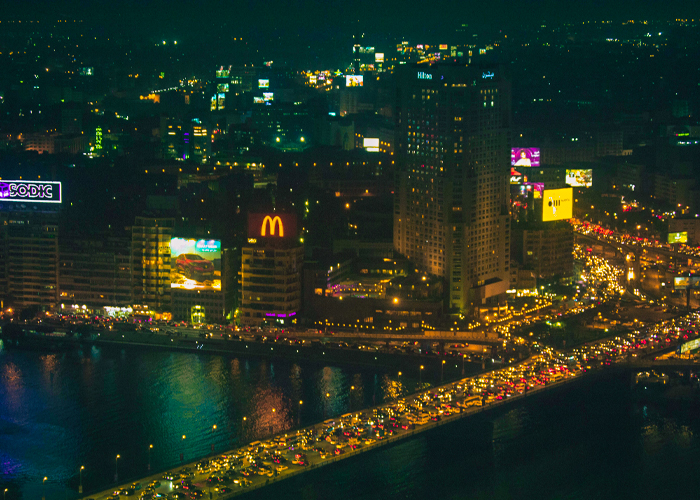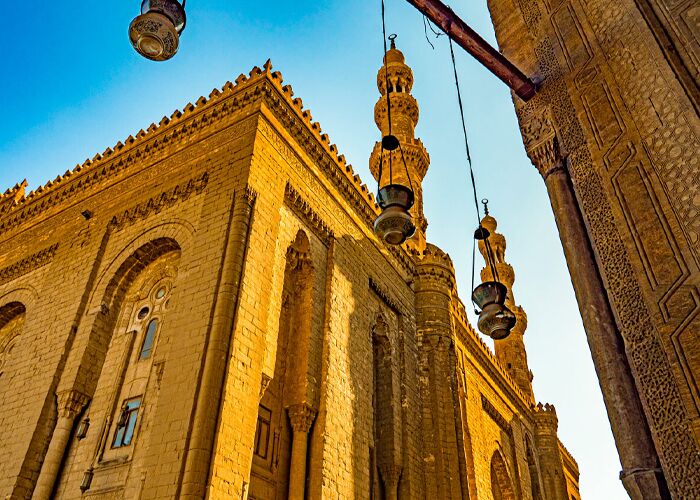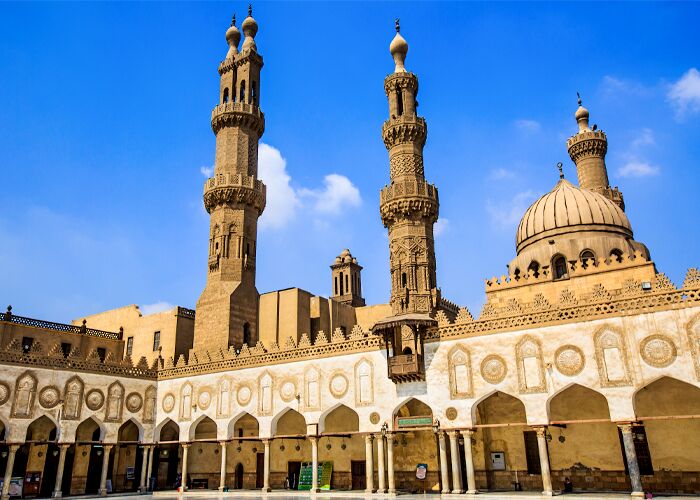One of the mosques that have great importance in architecture is the Mosque of Ibn Tulun. This Mosque is the oldest in Cairo although the Mosque of Amr Ibn Alas is the first mosque but does not retain its original structure. The Ibn Tulun Mosque is surviving in its original form.
Ibn Tulun Mosque – Cairo’s Enduring Islamic Masterpiece
Introduction
Ibn Tulun Mosque is one of Cairo’s most fascinating monuments, offering travelers an authentic glimpse into Egypt’s Islamic heritage. Unlike other historical sites that have undergone countless renovations, the mosque of ibn tulun cairo remains remarkably true to its original 9th-century design. Built by Ahmad Ibn Tulun, this mosque is not only the oldest surviving in Cairo but also the largest mosque in Cairo when measured by land area. For visitors, the tulun mosque is more than an architectural marvel—it is a serene retreat where centuries of history can be felt in every archway and courtyard. Whether referred to as the ahmad ibn tulun mosque, masjid ibn tulun, or ibn touloun, this monument holds a timeless beauty that makes it one of the must-see highlights for travelers exploring Islamic Cairo.
History and Foundation of the Mosque
The mosque of ahmad ibn tulun was commissioned in 876 CE by Ahmad Ibn Tulun, a Turkish-born general who rose to become governor of Egypt under the Abbasid Caliphate. Eager to demonstrate independence from Baghdad, Ibn Tulun established a new capital city, Al-Qata’i, and placed his mosque at its heart. This strategic choice reflected both his political ambition and his devotion to Islamic tradition.
When the Fatimids later destroyed Al-Qata’i, the mosque of ibn tulun in Cairo was the only building left standing. That resilience sets it apart from other structures in the city, ensuring its survival as one of the most important Islamic landmarks in Egypt. For today’s traveler, walking through its vast courtyards means treading the same ground that worshippers did more than eleven centuries ago.
The design of the ibn tulun mosque cairo egypt shows clear inspiration from Samarra in Iraq, the Abbasid capital at the time. The spiral minaret, in particular, echoes the style of the Great Mosque of Samarra. Such influences make it a fascinating stop for visitors who want to see how Islamic architectural styles traveled across regions and were adapted into local contexts. It remains the largest mosque in Cairo built in its era, a testament to Ibn Tulun’s ambition to create not just a religious building but a statement of permanence.
Architectural Features and Layout
One of the greatest appeals of the ibn tulun mosque cairo lies in its distinctive architectural features. Covering more than 26,000 square meters, it stands as the biggest mosque in Cairo in terms of sheer size. Constructed primarily of brick and plaster rather than stone, the mosque is unique compared to later mosques in Egypt.
The layout is defined by a large open courtyard surrounded by covered arcades. This design not only provided shade and comfort for worshippers but also created a serene environment that continues to impress visitors. The mosque’s pointed arches and carved stucco decorations reveal the skill of its craftsmen, while the uniformity of the design creates a sense of harmony.
One of the most striking features for travelers is the spiral minaret. Known for its distinctive “snail-shell” design, it offers panoramic views of Cairo for those willing to climb it. The stucco decorations, featuring geometric and floral motifs, are some of the oldest surviving examples in Egypt, giving visitors a rare chance to see original Abbasid artistry.
Every detail of the tulun mosque reflects both grandeur and function. The mosque’s orientation, large prayer hall, and ablution facilities were designed to serve thousands of worshippers at once. For modern visitors, these features also highlight how deeply integrated religion and community were in Ibn Tulun’s vision for his new city.

Religious and Cultural Importance
The mosque of ibn tulun cairo is more than just a place of worship; it represents a crucial chapter in Cairo’s cultural and religious evolution. For centuries, it has served as a community hub, hosting prayers, religious lessons, and gatherings. Unlike other historic mosques that were rebuilt over time, the ibn tulun cairo mosque has preserved its original form, making it an authentic window into Egypt’s early Islamic period.
As the largest mosque in Cairo of its time, the site was designed to accommodate large congregations, reflecting the importance of communal worship. The open courtyard remains a peaceful place for reflection, even for today’s visitors. Travelers often remark on the quiet atmosphere within its walls, a stark contrast to Cairo’s bustling streets outside.
Culturally, the masjid ibn tulun has influenced countless architects and builders. Its simplicity, symmetry, and use of decorative stucco became models for later Islamic monuments across Egypt and beyond. For international visitors, this means experiencing a site that not only embodies Egypt’s Islamic identity but also shaped architectural trends across the Middle East.
Ibn Tulun Mosque in Modern Times
Today, the ibn tulun mosque cairo egypt remains an active place of worship while also welcoming visitors from around the world. Restoration projects have helped preserve its structure without compromising its authenticity, allowing travelers to appreciate its historical details much as they appeared centuries ago.
For tourists, the mosque offers a chance to connect with a more contemplative side of Cairo. Unlike the crowded pyramids or bustling bazaars, the tulun mosque provides a quieter, more reflective experience. Many visitors climb the spiral minaret to enjoy sweeping views of Islamic Cairo, while others take time to explore the arcades and appreciate the craftsmanship of its stucco designs.
The mosque’s enduring charm also extends to popular culture. The mosque of ibn tulun Cairo has appeared in several films and documentaries, underscoring its timeless appeal. For travelers seeking authenticity, it is often considered one of the best-preserved Islamic monuments in Egypt, rivaling more famous sites in terms of historical depth.
Local guides often encourage visitors to combine a trip to the ibn tulun mosque with nearby attractions, such as the Gayer-Anderson Museum, housed in traditional Ottoman-era homes adjacent to the mosque. This combination makes for an enriching day exploring Cairo’s Islamic heritage.
Visiting the Mosque: Tips for Travelers
For those planning a visit to the mosque of ibn tulun, preparation can greatly enhance the experience. The mosque is located in the Sayyida Zeinab district of Cairo, easily accessible by taxi or organized tours. Most travel agencies, including local operators specializing in Islamic Cairo, include it in their itineraries.
Entry is usually free or requires a modest donation, making it one of the most accessible historical attractions in the city. Travelers should dress modestly, as it remains an active place of worship. Lightweight clothing that covers shoulders and knees is recommended, along with comfortable shoes for exploring the vast courtyards and climbing the minaret.
Photography is allowed, and the mosque provides countless opportunities for striking photos—whether capturing the interplay of light and shadow in the arcades or panoramic shots from the minaret. Visitors often remark that the mosque’s peaceful ambiance makes it a refreshing pause in a busy sightseeing schedule.
For those booking guided tours, many operators highlight the mosque of ibn tulun cairo as part of a broader journey through Islamic Cairo, alongside landmarks like the Citadel and Sultan Hassan Mosque. Pairing these visits gives travelers a fuller understanding of the city’s architectural and cultural layers.
Legacy and Lasting Influence
The ibn tulun mosque is not just a monument frozen in time—it is a living testament to the vision of Ahmad Ibn Tulun and the enduring legacy of Islamic architecture in Egypt. As the largest mosque in Cairo of its period, it set a precedent for later rulers who sought to leave their own mark on the city.
For architects and historians, the mosque remains a key reference point in the study of Islamic design. Its spiral minaret, courtyard plan, and stucco ornamentation influenced countless later structures. For travelers, this legacy is tangible in the way the mosque has been preserved: walking through it feels like stepping directly into the 9th century.
Its survival through political upheavals, invasions, and centuries of urban change also symbolizes Cairo’s resilience. The fact that the mosque of ibn tulun in Cairo still functions as a place of prayer today highlights how seamlessly history and modern life coexist in Egypt.
For visitors, the legacy of the mosque extends beyond architecture. It embodies the story of a visionary leader, a thriving city, and a cultural identity that continues to attract admiration from around the world. Travelers leave with not only photographs but also a deeper connection to Cairo’s Islamic heritage.

Conclusion
The ibn tulun mosque cairo egypt stands as one of the greatest treasures of Islamic Cairo, offering travelers a rare opportunity to experience history in its purest form. From its foundation by Ahmad Ibn Tulun to its enduring presence as the largest mosque in Cairo of its time, the mosque has captured the imagination of worshippers, architects, and travelers for more than eleven centuries.
Visiting the mosque of ibn tulun is more than sightseeing—it is an encounter with authenticity, serenity, and living history. For those exploring Cairo, it provides a moment of reflection, a lesson in architecture, and a chance to connect with Egypt beyond the well-trodden tourist paths.
Whether you call it the masjid ibn tulun, tulun mosque, or ibn touloun, this remarkable monument remains one of Cairo’s most rewarding destinations. For any traveler seeking to understand Egypt’s spiritual and cultural heartbeat, the journey is incomplete without stepping into the courtyards of the Ibn Tulun Mosque.










